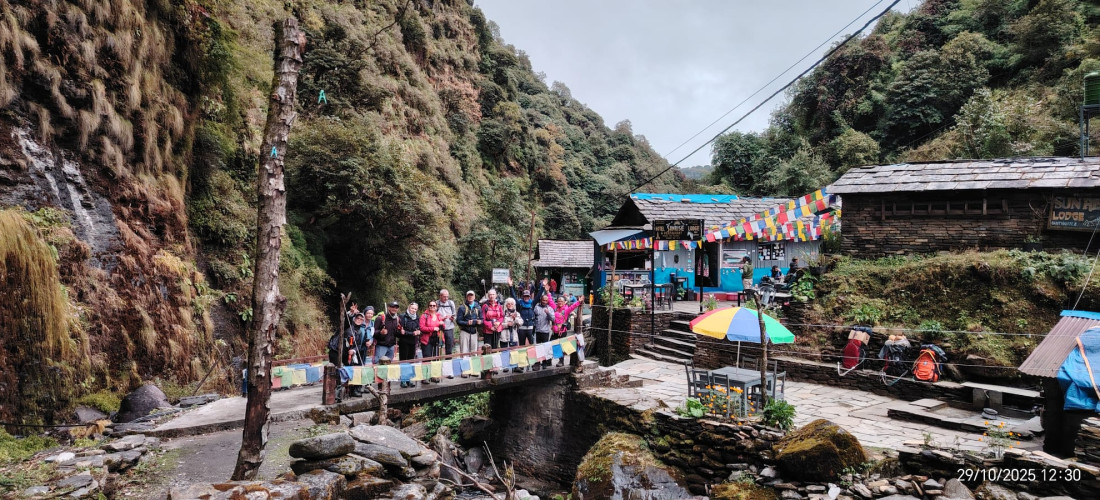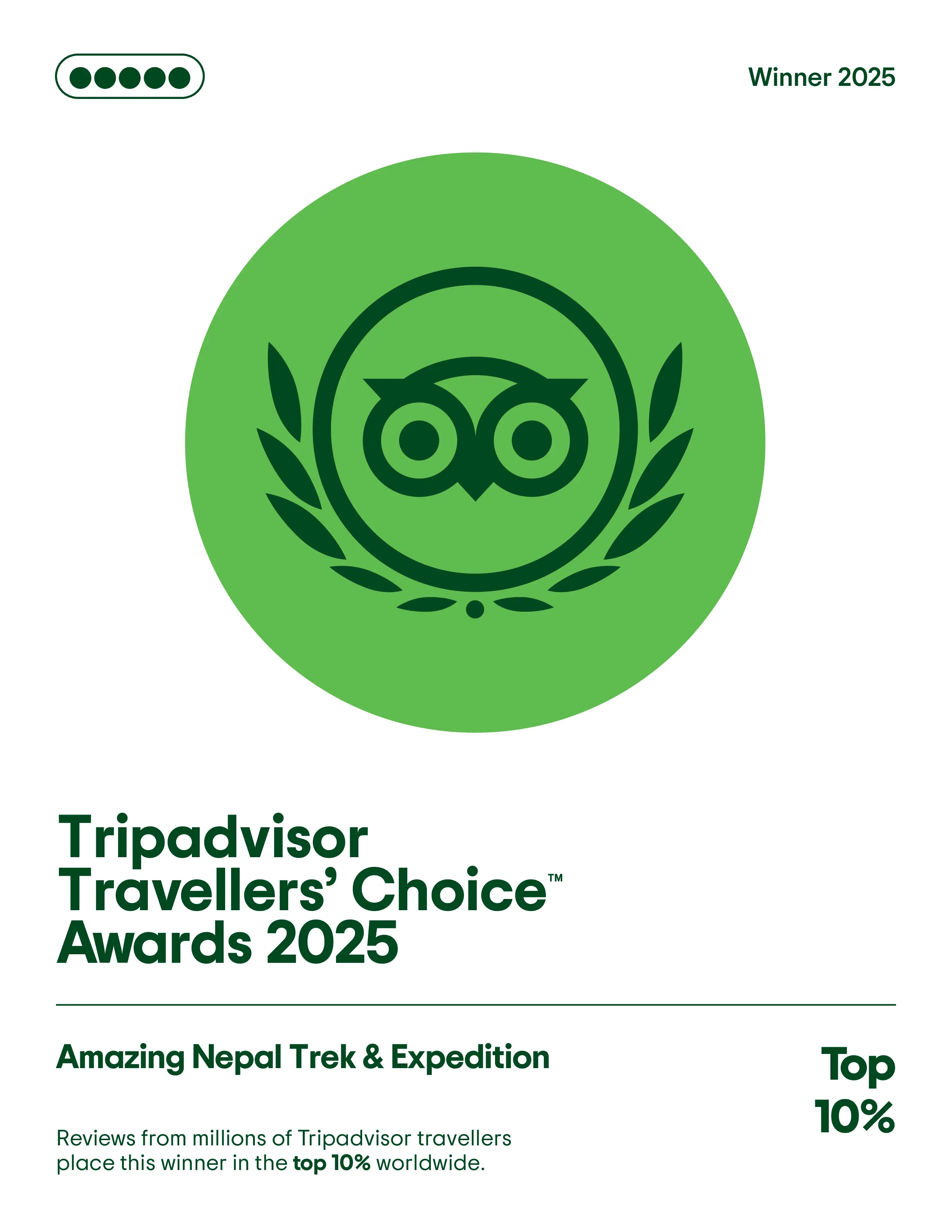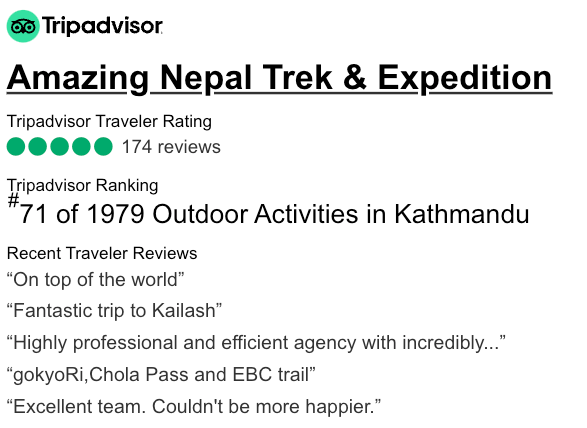The Langtang Valley trek offers you one of Nepal's most rewarding Himalayan experiences, combining stunning mountain scenery with rich cultural encounters just north of Kathmandu. This accessible yet spectacular route takes you through pristine forests, traditional Tamang villages, and high-altitude valleys surrounded by towering peaks. The region holds special significance as Nepal's first Himalayan National Park, protecting diverse ecosystems and preserving authentic mountain culture.
Choosing the right season transforms your trekking experience from good to extraordinary. Spring trekking in Nepal, particularly from March to May, presents the Langtang Valley at its absolute best. You'll witness nature awakening after winter's sleep, trails bursting with color, and mountain views so crisp they'll take your breath away.
This article explains exactly why spring is the best season to trek the Langtang Valley. You'll discover the unique advantages this season offers, from blooming rhododendron forests to perfect weather conditions, helping you plan the Langtang Valley trek of your dreams.
Overview of the Langtang Valley Trek
The Langtang trek Nepal takes you through one of the most accessible yet stunning Himalayan valleys, located just north of Kathmandu. This trekking route begins in Syabrubesi and winds through dense forests, traditional Tamang villages, and alpine meadows before reaching Kyanjin Gompa at 3,870 meters. Along the way, you'll encounter magnificent views of Langtang Lirung (7,227m), Ganesh Himal, and countless other peaks that define the region's dramatic skyline.
Langtang National Park, Nepal's first protected Himalayan region, serves as the backdrop for your entire journey. This conservation area protects rare wildlife including red pandas, Himalayan black bears, and snow leopards, while preserving the unique Buddhist culture of the Tamang and Sherpa communities who call these mountains home. The park's commitment to biodiversity conservation makes every step of your trek meaningful beyond the physical challenge.
A typical Langtang trek itinerary spans 7-10 days, depending on your pace and acclimatization needs. The trek is classified as moderate difficulty, making it suitable for trekkers with basic fitness levels and some hiking experience. Whether you're planning your Langtang trek March, Langtang trek April, or Langtang trek May, this Langtang trekking guide timeline allows for proper acclimatization while covering approximately 60-70 kilometers of trail. You'll gain significant elevation gradually, with daily walking times ranging from 5-7 hours through varied terrain that challenges without overwhelming.
Why Choose Spring Season for Your Langtang Trek?
The spring season, which runs from March to May, is widely regarded as the best time to trek in Langtang by many seasoned trekkers. This three-month period offers an ideal balance between the harsh cold of winter and the heavy rains of the monsoon.
Langtang Trek Weather in Spring
During spring, the weather in Langtang is generally pleasant with comfortable daytime temperatures ranging from 15°C to 20°C (59°F to 68°F) at lower elevations. Higher altitudes like Kyanjin Gompa experience cooler temperatures between 5°C to 10°C (41°F to 50°F) during the day. However, it's important to note that nighttime temperatures can drop significantly, often reaching -5°C to 5°C (23°F to 41°F) at higher camps. Fortunately, you can expect minimal rainfall during these months, with only occasional light showers that rarely disrupt trekking plans.
Comparing Spring with Other Seasons
Here's how spring compares with other seasons for trekking in Langtang:
● Winter (December-February): Freezing temperatures and heavy snowfall make trails difficult and some teahouses close
● Summer/Monsoon (June-August): Daily rainfall creates slippery trails, leeches become a problem, and mountain views are blocked by clouds
● Autumn (September-November): Great trekking conditions but trails become crowded with peak-season traffic
Spring strikes the perfect balance—you get stable weather patterns without the crowds that flood the region during autumn. The warming temperatures melt winter snow from lower trails while keeping higher elevations beautifully snow-capped, giving you the best of both worlds for your Himalayan adventure.
1. Natural Beauty of the Langtang Valley in Spring
Spring transforms the Langtang Valley into a living canvas of colors that you simply won't experience during other seasons. The rhododendron forest Langtang becomes the star attraction, with Nepal's national flower painting the hillsides in brilliant shades of red, pink, white, and purple. These ancient forests create natural tunnels of color that you'll walk through for hours, making every step of your journey feel like you're trekking through a botanical wonderland.
The blooming flowers Langtang trek extends far beyond rhododendrons. You'll encounter primulas, orchids, and countless wildflower species carpeting the meadows and forest floors. The valley's elevation range means you'll experience different floral displays as you ascend, with new varieties appearing at each altitude zone.
The vibrant wildlife Langtang becomes noticeably more active during spring months. Red pandas emerge from their winter retreats, Himalayan tahr graze on fresh vegetation, and you might spot the elusive musk deer in early morning hours. Bird enthusiasts will appreciate the increased activity of pheasants, eagles, and numerous songbird species.
This explosion of life creates an immersive sensory experience. The sweet fragrance of blooming flowers fills the air, the sounds of wildlife echo through the valleys, and the contrast between lush greenery and snow-capped peaks creates photographic opportunities at every turn. You're not just trekking through mountains—you're experiencing nature's grand awakening.
2. Clear Skies and Panoramic Mountain Views
Spring transforms the Langtang Valley into a photographer's paradise with its exceptional Himalayan peaks visibility. The dry air and minimal cloud cover during March through May create perfect conditions for capturing the majestic snow-capped mountains that define this region. You'll witness Langtang Lirung (7,227m), Ganesh Himal, and dozens of other peaks standing in sharp relief against brilliant blue skies.
The clear skies Langtang trek offers during spring mean you can plan your photography sessions with confidence. Unlike autumn when afternoon clouds often obscure the mountains, spring mornings and evenings consistently deliver crystal-clear views. You'll find yourself stopping repeatedly along the trail, camera in hand, as each turn reveals another breathtaking vista.
Kyanjin Gompa serves as your premier vantage point for panoramic mountain views. From this high-altitude settlement at 3,870 meters, you're surrounded by a 360-degree amphitheater of peaks. The nearby Tserko Ri viewpoint (4,984m) rewards your early morning climb with sunrise illuminating the entire Langtang range in golden light.
Langtang Valley viewpoint and the ridge above Kyanjin Ri (4,773m) provide equally stunning perspectives. You'll capture images here that rival any professional mountain photography, with the stable spring weather ensuring your efforts aren't wasted by sudden cloud cover or precipitation. The visibility extends for dozens of kilometers, allowing you to identify distant peaks and glaciers with remarkable clarity.
3. Safer and More Enjoyable Trails
Spring transforms the Langtang Valley into a trekker's paradise with dry trails Langtang trek conditions that significantly improve your hiking experience. The paths become firm and stable after winter, creating ideal walking surfaces that reduce fatigue and allow you to focus on the stunning surroundings rather than watching every step.
Trail accessibility spring season reaches its peak during March through May. You'll find:
● Well-defined paths free from snow accumulation that often blocks routes in winter
● Minimal mud and slippery sections compared to monsoon months
● Stable ground conditions that make steep ascents and descents more manageable
● Better visibility of trail markers and route indicators
The reduced risk of landslides during spring gives you peace of mind throughout your journey. Unlike the monsoon season when heavy rains trigger dangerous slope failures, spring's stable weather patterns keep the mountainsides secure. You won't face the anxiety of sudden trail closures or dangerous detours that can disrupt your itinerary.
Rain showers in spring are typically brief afternoon occurrences rather than the relentless downpours of summer. This predictable pattern allows you to plan your daily trekking schedule effectively—starting early to cover most distance during dry morning hours and reaching your destination before any potential weather changes.
The combination of dry, accessible trails and stable weather conditions means you can trek with confidence, knowing the route ahead is both safe and enjoyable.
4. Cultural Richness During Spring Trekking
Spring brings new life to the local villages along the Langtang trek, offering you authentic cultural encounters that define the cultural richness of Nepal trekking experiences. The warming weather brings communities outdoors, where you'll witness daily life unfolding in vibrant detail—farmers preparing fields, children playing in village squares, and locals gathering for social exchanges that welcome curious trekkers.
Traditional Celebrations and Community Activities
The timing aligns perfectly with several traditional celebrations. You might encounter Holi festivities painting villages in brilliant colors or witness Buddhist ceremonies at ancient monasteries where monks perform rituals unchanged for centuries. The Tamang and Sherpa communities that call this valley home become particularly active during spring, organizing cultural events and religious observances that you can respectfully observe or even participate in.
4.Authentic Cultural Experiences with Locals
Why Spring is the Best Season to Trek the Langtang Valley becomes evident when you share butter tea with villagers in their stone houses, decorated with fresh spring flowers. The hospitable locals have more time to engage with visitors during this season, sharing stories about their heritage, demonstrating traditional crafts, or inviting you to observe cheese-making processes in high-altitude settlements.
Warmth of Tea Houses and Lodges
Tea houses and lodges buzz with warmth and conversation. You'll find yourself exchanging travel stories with fellow adventurers while local families prepare authentic dal bhat, their generosity reflecting the season's abundance and the genuine Himalayan hospitality that makes this trek unforgettable.
5. Practical Tips for Spring Trekking in the Langtang Valley
Preparing properly for your spring trek makes all the difference between a good experience and an exceptional one. You need to pack smart for the variable weather conditions you'll encounter in the mountains during this season.
Essential Gear and Clothing
Spring weather in Langtang brings mild days but chilly mornings and evenings. You should pack:
● Layering system — base layers, fleece mid-layers, and a waterproof outer shell
● Warm sleeping bag rated for -10°C to -15°C for higher elevations
● Sun protection including high-SPF sunscreen, sunglasses, and a wide-brimmed hat
● Sturdy trekking boots with good ankle support and waterproof capabilities
● Trekking poles to ease the strain on your knees during descents
Acclimatization and Hydration Strategies
Altitude sickness can affect anyone, regardless of fitness level. You should ascend gradually, following the "climb high, sleep low" principle whenever possible. Build rest days into your itinerary at key elevations like Kyanjin Gompa (3,870m).
Drink at least 3-4 liters of water daily to combat dehydration at altitude. You can purify water using tablets or filters rather than buying bottled water at every teahouse. Watch for symptoms like headaches, nausea, or unusual fatigue — these Langtang trek tips could save your journey from turning into a medical emergency.
Personal Experiences from Spring Trekkers
The Langtang trek experience during spring consistently earns praise from adventurers who've walked these trails. You'll find trekkers describing their journey as "transformative" when they witness the valley bursting with rhododendron blooms against the backdrop of pristine Himalayan peaks.
Many share stories of perfect weather windows that allowed them to capture stunning photographs at Kyanjin Gompa, with crystal-clear views of Langtang Lirung dominating the horizon. The comfortable daytime temperatures meant they could trek in light layers, enjoying the physical challenge without battling extreme cold or monsoon rains.
Trekkers frequently mention the vibrant atmosphere in teahouses during spring, where they connected with fellow adventurers from around the world. The hospitable Tamang communities left lasting impressions, with visitors recounting warm conversations over butter tea and memorable cultural exchanges.
Wildlife encounters add another dimension to spring trek stories. You'll hear accounts of red pandas spotted in the bamboo forests, Himalayan tahrs grazing on hillsides, and diverse bird species active during the breeding season. These spontaneous moments create the authentic wilderness experience you're seeking in the Himalayas.
Why Choose Amazing Nepal Trek for Your Spring Langtang Trek?
Amazing Nepal Trek has many years of experience in organizing treks in the Langtang region during spring. We combine our in-depth knowledge of the area with professional trekking skills to provide you with an unforgettable experience. As a local trekking guide Nepal operator, we have guides who grew up in these mountains and know exactly how spring weather patterns can affect the trails, wildlife, and cultural events in the valley.
More Than Just a Guide
When you trek with Amazing Nepal Trek, you get more than just a guide. Our team has valuable insights that will enhance your journey:
● We know which rhododendron groves bloom first in March, where to spot red pandas during April mornings, and which teahouses offer the warmest hospitality during unpredictable spring temperatures.
● Our guides are multilingual and can communicate with various communities along the route. They serve as cultural interpreters, helping you connect authentically with Tamang and Sherpa people.
Safety First
Your safety is our top priority during the Langtang trek spring season. We have implemented several measures to ensure a secure journey:
1. Real-time weather monitoring: Our team closely monitors weather conditions to stay updated on any changes that may impact your trek.
2. Flexible itinerary adjustments: If necessary, we can make last-minute changes to your itinerary based on the weather forecast or other factors affecting trail conditions.
3. Proper acclimatization schedules: We understand the importance of acclimatization in preventing altitude sickness. Our itineraries are designed with sufficient rest days to help you adjust gradually to higher altitudes.
Local Partnerships for Authenticity
We believe that supporting local communities is essential for sustainable tourism. That's why we have established partnerships with local businesses along the trekking route:
● Best accommodations: Through our connections with guesthouses and lodges, we can guarantee comfortable stays that reflect the local culture.
● Support services: We collaborate with local porters and support staff who play a crucial role in making your trek successful.
By choosing Amazing Nepal Trek, you not only get an incredible adventure but also contribute positively to the lives of people living in these remote areas.
Plan Your Spring Adventure in the Langtang Valley!
The spring trekking advantages in the Langtang Valley are undeniable — from blooming rhododendrons painting the hillsides in vibrant colors to crystal-clear mountain views that photographers dream about. You've seen why spring is the best season to trek the Langtang Valley, and now it's time to turn that knowledge into action.
March to May offers you the perfect window to experience this Himalayan gem at its absolute finest. The trails are dry, the weather is cooperative, and nature puts on its most spectacular show. You'll walk through landscapes that come alive with color and energy, creating memories that last a lifetime.
Ready to start your Langtang trek adventure? Amazing Nepal Trek is here to transform your trekking dreams into reality. Our experienced guides know every twist and turn of the trail, understand the seasonal nuances, and are committed to making your journey safe, comfortable, and unforgettable.
Contact Amazing Nepal Trek today and let us craft your perfect spring trekking experience in the Langtang Valley. Your Himalayan adventure awaits!
FAQs (Frequently Asked Questions)
Why is spring considered the best season to trek the Langtang Valley?
Spring, from March to May, offers ideal weather conditions with mild temperatures and minimal precipitation. The trails are dry and safe, allowing for easier trekking. Additionally, this season showcases blooming rhododendron forests, vibrant wildlife, and clear skies that provide panoramic views of the Himalayan peaks, enhancing the overall trekking experience.
What are the major highlights of the Langtang Valley trek during spring?
During spring, trekkers can enjoy lush greenery, blooming wildflowers like rhododendrons, and active wildlife sightings within Langtang National Park. The clear skies offer unobstructed views of snow-capped Himalayan peaks. Moreover, interacting with local communities celebrating seasonal festivals adds cultural richness to the journey.
How does the weather in spring compare to other seasons for trekking in Langtang Valley?
Spring features mild temperatures ranging from cool mornings to warm afternoons with low chances of heavy rain. Unlike the monsoon season, which brings landslides and slippery trails, spring's dry conditions make trails safer and more accessible. Compared to winter's cold and snow-covered paths, spring provides a comfortable climate for trekking.
What practical tips should trekkers keep in mind when planning a spring trek in Langtang Valley?
Trekkers should pack gear suitable for variable but mild weather, including layers for changing temperatures. Proper acclimatization is essential to prevent altitude sickness, along with staying well-hydrated throughout the trek. It's advisable to wear sturdy footwear for dry trails and carry sun protection due to increased exposure under clear skies.
How does choosing a local operator like Amazing Nepal Trek enhance a spring trekking experience in Langtang Valley?
Amazing Nepal Trek offers expert local guides who are knowledgeable about seasonal conditions and cultural nuances unique to Langtang Valley during spring. Their experience ensures safe navigation on well-maintained trails while facilitating meaningful interactions with local communities. This support enriches both safety and cultural immersion for trekkers.
What cultural experiences can trekkers expect during a spring trek in Langtang Valley?
In spring, trekkers have opportunities to engage with local villages where residents celebrate seasonal festivals and maintain traditional lifestyles. This period highlights cultural richness through interactions that provide insights into Nepalese mountain community life, making the trek not only a natural adventure but also a culturally rewarding experience.








